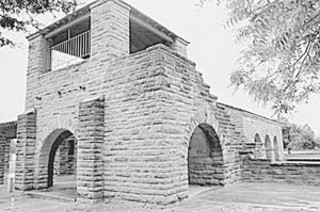Day Trips
Abilene State Park is an oasis in the parched, red-dirt prairie
By Gerald E. McLeod, Fri., Sept. 3, 2004

Abilene State Park doesn't look much like most of the land around Abilene. Instead of the parched, red-dirt prairie with its sparse tufts of buffalo grass and scrawny trees that is most often associated with the area, the park is a tree-shaded campground along the creek.
"We're kind of an oasis among the mesquite and cedar," says park manager Okie Okerstrom. "We have lots of trees – oak, pecan, and hackberry. It has to do with the creek and geology."
Elm Creek, a spring-fed tributary of the Brazos River, has been watering the thick stand of trees for thousands of years. The Tonkawas, Comanches, and other Indian tribes camped here while they waited for the buffalo to funnel through the gap in the low mountains called the Callahan Divide. White settlers named the gap and the settlement five miles north of the park Buffalo Gap, after the pass in the hills.
Native pecan trees line the creek bed where Indian ponies and tepees once stood. "We're known for the thousand pecan trees in the park," Okerstrom says. The small nuts are more flavorful then their larger cousins, but more work. "Folks are welcome to pick them up by the handful, but not the bucket full," she says. "[The nuts] are a food source for the wildlife."
The abundant wildlife in the 621-acre park is one of Okerstrom's favorite parts of her job. "[This park] is a real attitude adjustment," she says. "It's just wonderful." Okerstrom, who has been at the park about seven years, grew up in the Abilene area and has been coming here since she was a child attending family reunions.
The park is still popular with family reunions because of its central location in West Texas. "We have families come from all over every year," she says. "Everybody remembers the cold swimming pool."
During the Great Depression, President Franklin D. Roosevelt put thousands of unemployed men to work building public facilities with the Civilian Conservation Corps. One of the first projects in Texas was on land donated to the state by the city just below the dam of Lake Abilene. Between 1933 and 1935, veterans of World War I built a spring-fed swimming pool, concession building, roads, and a water tower of red sandstone quarried from the nearby hills. Later, a group of African-American veterans came to add embellishments that give the park a solid, cohesive feel.
The almost-Olympic-sized pool is the park's most popular feature. In continuous use since the Thirties, it is open from Memorial Day to Labor Day. "I remember when the concession stand rented bathing suits. They came with a big pin so that everybody could recognize that it was a rented suit," Okerstrom says with a laugh. "I'm glad we don't do that anymore."
It's not surprising that fall is the park manager's favorite time of year. "The leaves are changing colors, the weather is nice, and wildlife are more active," she says. Even the park's four longhorns, part of the state herd, seem to feel their oats after Labor Day. The resident buffalo, Blu, tends to be a little more frisky. "She's still pretty wild anyway," Okerstrom says.
Any time of year, there is plenty to do during a visit to the park. A mile-and-a-half-long nature trail meanders through the dense woodlands and across wooden footbridges. Bicyclists enjoy the miles of park and country roads.
Although the park does not have any lakefront property, Lake Abilene is a short distance away. "It's a 'muddy water' lake," Okerstrom says. Inside the park is Buffalo Wallow, a small pond popular with anglers looking to hook a catfish in the summer or a trout in winter. "The pond is an old gravel pit and is nice and clear. It's a good place to take kids fishing," she says.
Abilene State Park is south of Abilene, about four hours from Austin, off of U.S. 84 and FM 89 near Buffalo Gap. Camping facilities include RV sites, screen shelters, camping areas with water and electricity, and primitive camping areas. To contact the park, call 325/572-3204. For reservations, call 389-8900 or log onto the TPWD Web site at www.tpwd.state.tx.us.
690th in a series. Day Trips, Vol. 2, a book of Day Trips 101-200, is available for $8.95, plus $3.05 for shipping, handling, and tax. Mail to: Day Trips, PO Box 33284, South Austin, TX 78704.








